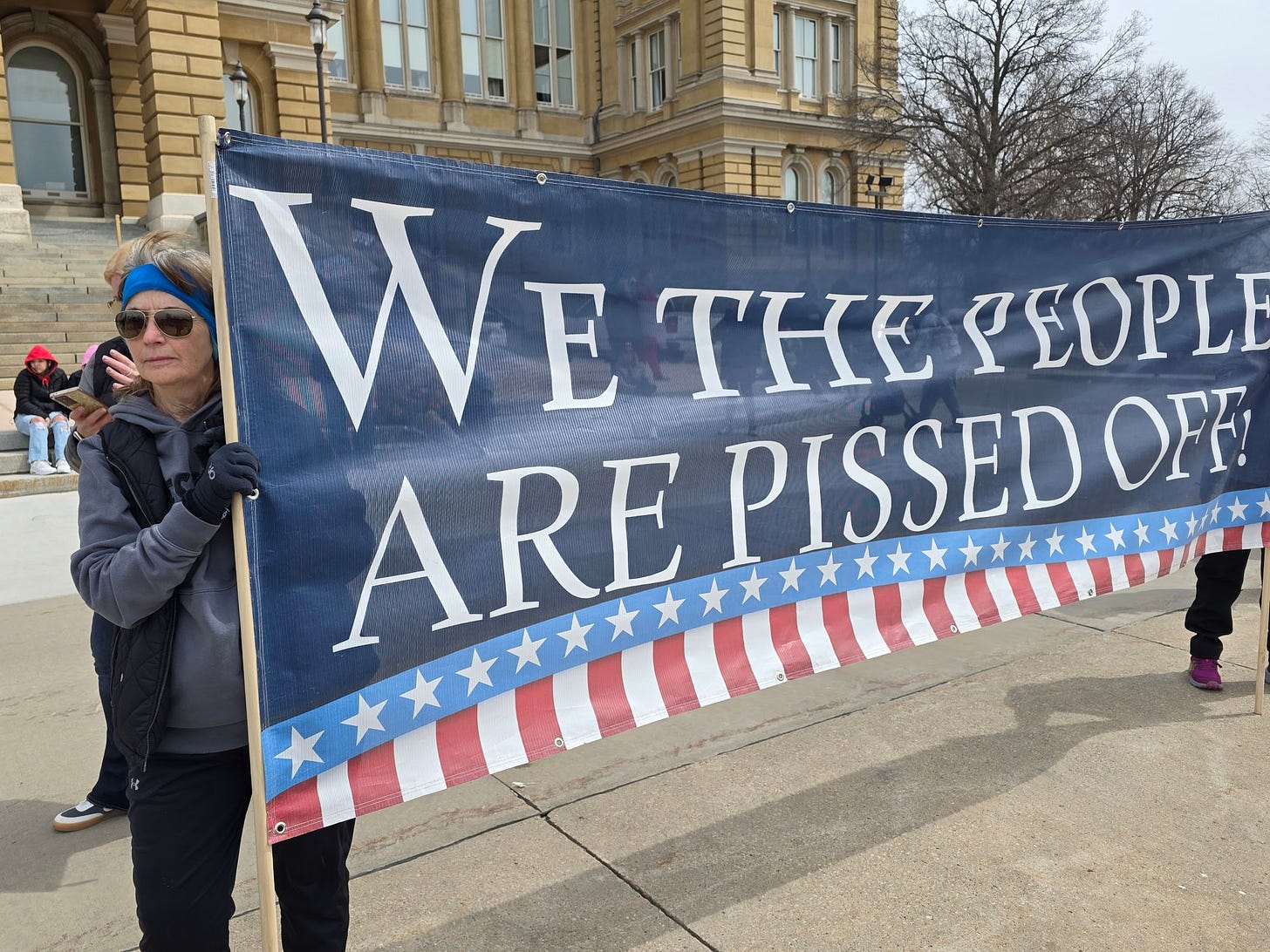Journalists Aren't Capturing the True Fury of Trump Protesters
Anger in the streets is not getting through
As opposition to Trump policies grows across the country, it seems that most journalists just aren’t getting it.

Photo courtesy of Bob Leonard’s Deep Midwest Politics column, part of the Iowa Writers’ CollaborativeThe mass protests in Des Moines and other Iowa cities this past Saturday were covered, but I would rate the coverage as routine. Ho hum. Another garden variety protest rally.
I sense many citizens are furious at how our government is being torn apart, how immigrants are being seized and shipped out of the country with no due process rights, how Trump is attacking universities, law firms and the news media itself. Iowans are frightened seeing their investment accounts wither away under Trump’s reckless tariffs. People are shocked that Congress shirks its duties and lets Trump run rampant. Fury. Fright. Shock. And my point is that none of that emotion is coming through in the coverage.
On the local TV news, the stations showed a crowd shot here, a protest sign there, a sound bite – all standard stuff. The Sunday print Des Moines Register had not one mention of the rally in Des Moines early Saturday afternoon that attracted thousands of people. Not once did I see a reporter describe the mood of the crowd.
Don’t get me wrong. It’s not a reporter’s job to take sides – to be a cheerleader for one side or the other. But it’s also not a reporter’s job to be a mere stenographer.
Good reporters should do more than just report who said what and when. Good reporters should describe what it felt like to be there. They are the viewers’ eyes, ears and heart! Describe the emotion of the moment.
We can’t just be C-SPAN
The best example I can think of to demonstrate what good reporters should do took place in the newsroom I ran. At the time, we had an outstanding and experienced courts reporter. He was covering a sensational murder trial. At the conclusion of testimony one day, he raced back to the newsroom and told us, “I’ve never seen testimony this emotional! It was an incredible day. We have some really powerful stuff.”
As I sat in my office to watch the 6:00 pm lead story on this emotional day in court, I was disappointed to see a completely routine, ordinary trial story that communicated none of the emotion he had told colleagues about in the newsroom. I called him in and said, “What happened? I thought you said this was the most emotional testimony you had ever witnessed in court. But you treated the story as if it were the noon report on livestock markets!”
This very good reporter said he was trying to be a detached observer and report “just the facts.” I begged to disagree and told him, “You’ve done this for 20 years. Our viewers know you. They trust you. If you witness the most powerful testimony you’ve seen in your whole career, tell our viewers that! You’ve got to communicate to our viewers what it felt like to be there. Don’t sanitize the story. Otherwise, we’re no different than C-SPAN. We’ve got to do better than just the facts. Viewers can get the facts lots of places. What they can’t get elsewhere is the perspective of what it was like to be in that courtroom today. Take our viewers there and let them feel it.”
Why that is not happening in protest coverage is likely due to that in-bred journalistic instinct to play things down the middle, rather than some intentional effort to downplay the protests. Particularly in this intense political climate, reporters are bending over backwards. Or more probably, bending over backwards to avoid any accusations of bias. So they play it safe, stick to the basic facts and nothing more.
But something important is getting lost if reporters don’t communicate the emotion of the stories they cover. It doesn’t matter if it’s thousands of people marching against Trump in downtown Des Moines or thousands of people at a MAGA rally cheering the guy they believe is the Messiah. As a viewer or reader, I want to know what it feels like to be in that crowd.
The time is now to swing for the fences
I got a better sense of Saturday’s rallies by looking at social media and some of my cohorts in the Iowa Writers’ Collaborative than I did from major media outlets. Guys like Bob Leonard know how to tell a story.
Good reporters can sense when they’ve got a juicy story on their hands, and they skillfully use their powers of observation, their writing skills and their storytelling abilities to swing for the fences and knock it out of the park.
Sadly, with coverage of all the gut-wrenching stories affecting our lives the past few months, I’m seeing far too many bunt singles and not nearly enough home runs.
Proud to be a member of the Iowa Writers’ Collaborative with such skillful storytellers as Bob Leonard, Art Cullen, Laura Belin, Ed Tibbetts, Julie Gammack, Cheryl Tevis and many more. Check out the full roster here.




I was there. You’re correct again, Dave! There was seething anger, accompanied by a sense of helplessness and hopelessness due, I believe, to Iowa’s single party madness, our legislative imbalance, the irreparable damages being wrought, and a worthless congressional delegation.
Only the ballot box can save us!
Excellent analysis, Dave! A mere recitation of facts doesn’t tell the story. Context and analysis are not “spin.” They are essential to telling a factual story.